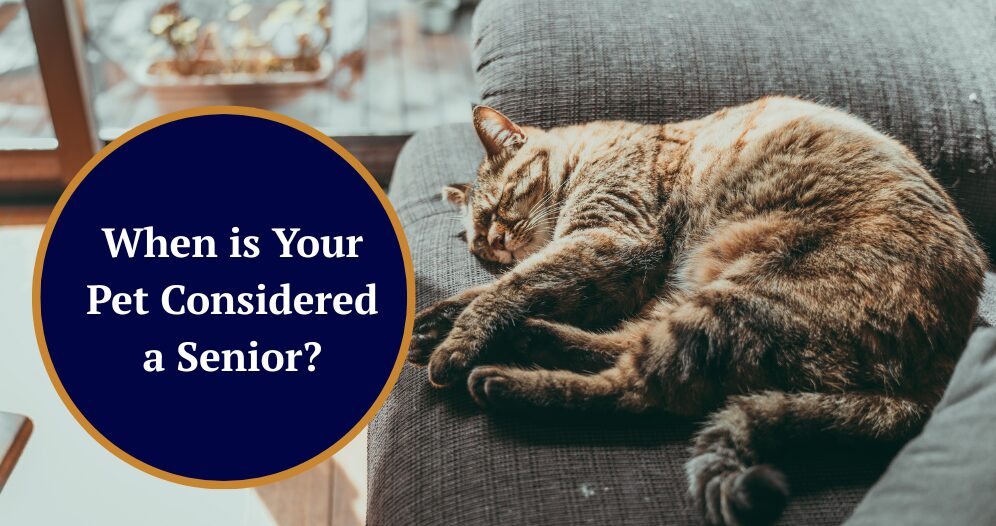
We love our pets through every stage of life, from their playful days to their more peaceful later years. Watching them grow older can be emotional, but it’s also one of the most meaningful experiences.
As pets enter their senior years, their needs begin to change. They may move more slowly, rest more often, or simply need a little extra care and attention. By understanding these changes and adjusting their routines accordingly, you can help ensure your pet stays happy, healthy, and comfortable as they grow older.
When is My Pet Considered a Senior?
Just like us, pets age – but at different rates. Cats, for example, typically begin senior wellness care around age 7, as they transition from young adulthood into middle age. By the time they’re 10, most vets consider them officially senior. At 15 and beyond, your cat is likely in their geriatric stage.
For dogs, the definition of “senior” is a bit more specific and depends on breed and size.
- Small dogs are generally considered seniors between 10 and 12 years old.
- Medium-sized breeds hit senior status around 8 to 9 years old.
- Large and giant breeds tend to age faster and are often considered seniors between 5 and 7 years old.
Additionally, the rate at which pets age changes over time. While many people assume one dog year equals seven human years, the actual comparison is a bit more complex. Dogs age at different speeds throughout their lives, especially during the early stages. According to the American Kennel Club, when a dog year old, it is roughly equivalent to 15 years old in human terms. By age 2, dogs are closer to 24 in human years. From there, the rate of aging begins to slow, averaging about four human years for every additional dog year – but this depends on the breed and size of the dog itself.
Cats follow a similar pattern. During their first year, they develop quickly and are comparable to a 15-year-old human. By their second birthday, they are closer to 24. After that, most cats age at a rate of about four human years for each additional year.
Every pet is unique, but knowing when they enter their golden years can help you stay ahead of age-related changes and make the proper adjustments to their care.
Changes in Senior Pets
As pets grow older, their lifestyle and care requirements naturally evolve. What kept them happy and healthy in their younger years might not be quite enough anymore. You may notice them slowing down, needing more rest, or a little extra help with their daily routines.
Being aware of these shifts can make a meaningful difference in your pet’s quality of life. This chapter is all about proactive care – focusing on comfort, preventing health issues before they start, and making sure they feel loved and supported.
Vet Visits
For dogs, the frequency of vet visits also changes as they age. While young dogs typically only need an annual check-up, older dogs should be seen every six months for routine exams and preventative tests. The specific timing may vary depending on the dog’s breed and health, so it’s important to work closely with your veterinarian to determine the right schedule for your pet
Once a cat reaches age 10, it’s recommended they visit the vet every six months. This is an increase from the typical annual appointment for adult cats, but it allows vets to keep a closer eye on aging pets through blood work and routine exams.
Health Concerns
As dogs age, they may become more susceptible to a variety of health issues, including cancer, arthritis, heart disease, kidney disease, and cognitive dysfunction. Many senior dogs also face dental disease, vision loss, and hearing impairment. While some of these conditions are a natural part of aging, many can be managed or even prevented with proper care. A balanced diet, regular exercise, and consistent vet visits are key to maintaining your dog’s health. Regular dental care can help prevent painful dental disease, and early detection through veterinary check-ups can catch potential problems before they become serious.
For cats, the aging process brings its own set of challenges. Kidney disease, arthritis, hyperthyroidism, cancer, and cognitive dysfunction are among the most common health issues senior cats face.
These conditions can significantly affect your cat’s comfort and well-being, but with proactive care, many can be effectively managed. Regular vet visits are essential for monitoring their health and catching any issues early. Maintaining a healthy weight and providing nutritious food can help prevent age-related conditions, ensuring your cat remains comfortable and healthy as they enter their senior years.
Exercise
As dogs age, their exercise needs shift. Senior dogs benefit from low-impact activities, such as walking, swimming, or gentle play, with about 30 to 60 minutes of exercise per day. As they get older, this may decrease to 15 to 30 minutes.
Adult cats typically engage in 30 minutes of active play per day, but senior cats should transition to gentler, shorter sessions of no more than 15 minutes.
Supporting a Senior Lifestyle
While it’s bittersweet to watch our pets grow older, many senior pets still have plenty of joyful years ahead. By creating a supportive environment, you can enhance their comfort, happiness, and quality of life.
- Comfortable Living Environment: Soft, accessible bedding is key for supporting older pets in your home. Consider adding ramps or stairs to help them reach furniture with ease. Temperature control can also help soothe achy joints, keeping them comfortable.
- Mental Stimulation: Keep your pet’s minds engaged with puzzle feeders, short training sessions, and new (safe) smells or toys. Maintaining a consistent routine also offers predictability, which can help reduce stress on senior pets.
- Diet & Nutrition: Implement senior-specific food in your pet’s diet, as these formulas often provide lower calories and added support for joints and heart health. Be sure to encourage your pet to stay hydrated and consult your vet about recommended supplements to support their health.
Preparing for the Next Chapter
Caring for a pet through every stage of life is one of the greatest privileges of pet ownership. From their first playful years to their quiet senior days, your presence and patience mean everything to them. Many older pets continue to enjoy their routines and family life well into their golden years. With a little extra care and attention, you can help make these years as fulfilling as possible.
It’s also important to be prepared for the changes that may come. If your pet’s health begins to decline, or if you’re facing difficult decisions, you don’t have to go through it alone. We encourage you to read our blogs on Comforting Your Pet at the End and What to do if Your Pet Dies at Home, written to help you navigate this emotional time with clarity and care.
At Pet Cremation Services, we are here to support pet parents as they prepare for the final farewell, grieve, and remember their beloved companions. Whether your pet has many good years ahead or you’re beginning to plan for the end, we’re honored to walk alongside you. Together, we can help you honor the life and legacy of your cherished companion.

